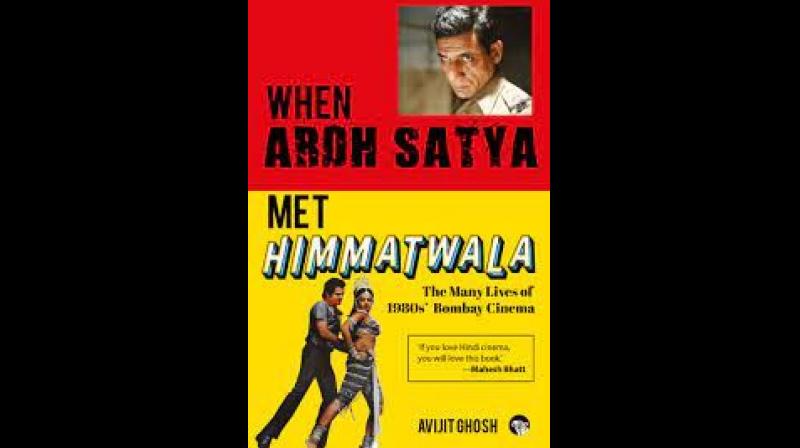Book Review | 1980s: The decade of kitsch and melodrama in Bollywood cinema

The period from the late 1940s, after India’s independence, to the 1970s is regarded by film historians as the Golden Age of Hindi cinema. Some of our most iconic films were produced during this time, Awaara, Mother India, Pyaasa, Mughal-e-Azam, Pakeezah and, of course, Sholay.
There is also some consensus that the decade that followed, the 1980s, were terrible years for Indian cinema. The muses were in retreat and the films were almost uniformly bad. Cinema halls, built fifty or so years earlier, had decayed with rats taking over. One had to be very brave to use their toilet facilities.
As for the films, there was little by way of plot but there were lots of fisticuffs. These films. They were intended for the male only front benches while the middle class stayed home and watched pirated videos of foreign films, Pakistani serials and the few good Hindi films that continued to be made.
Little is written about this decade and for that reason Avijit Ghosh’s When Ardh Satya Met Himmatwala is all the more welcome. The title of the book says it all, Govind Nihalani’s Ardh Satya was among a handful of films of the eighties worth watching. It was made on a shoe string and was a surprising hit. Om Puri gave the performance of his life as the compromised cop.
The biggest hit of the decade was Himmatwala that came from the south and brought along with it Sridevi and her thunder thighs. As Ghosh puts it “she became a stairway to heaven for millions of sweaty cinegoers in sweatier theatres.” Jitendra, also no mean dancer, was the hero of the film. Ardh Satya was sublime, Himmatwala was ridiculous.
The author of this engrossing book was in college at that time and cinema was his passion. He recalls everything he saw those days, with whom and where. He waited with his buddies impatiently for the ticket counter to open, taking turns to stand in the queue. They were not particularly choosy about what they saw, from the Thodisi Bewafai, that packed in ladies at afternoon shows to barely watchable Paanch Qaidi.
Today, Ghosh writes on films for a major newspaper. He is the person in the press room that the editor turns to when he needs an obituary of anyone involved with films. When he was approached by a publisher to write a book on the cinema of the 1980s he accepted the assignment with delight.
It was a time when the film industry was fighting for its survival. Every family that could afford it had a television set with a VCR attached to it. Remember them? They watched with impunity pirated tapes that could rented out in every neighbourhood.
Sometimes these videos were available on the very first day of film’s release in cinema halls. The copies were often terrible, filmed surreptitiously by someone in a cinema hall. The television sets had gone from black and white to colour. The producers were reduced to making conveyor belt films that catered to the underclass who did not possess television sets and students who needed a break from hostels.
Films continued to be made in record numbers by fly-by-night producers hoping for a hit. In 1985 alone 185 films were released, a record number that overtook the previous high of 183 films in 1947.
A handful of stars were in great demand. Mithun Chakraborty acted in over a hundred films within ten years of the eighties. Govinda was a top draw, popular at the box office but not so popular with his colleagues. He had the notorious habit of turning up late for shoots keeping even senior artists waiting for hours. There was a good reason, he was doing four shifts a day.
But it was Amitabh Bachchan who was the top star of the eighties playing the angry young man over and over again. His character was invented by the writing team of Salim Khan and Javed Akhtar and four directors, Prakash Mehra, Yash Chopra, Manmohan Desai and Hrishikesh Mukherjee. Soon the audiences got bored even with his films and towards the end of the eighties his films too did poorly at the box office. Main Azaad Hoon, Gangaa Jamunaa Saraswati, Toofan and Jaadugar were flops.
The 1980s were somewhat redeemed by a handful of good films. Besides Ardh Satya, there were Salaam Bombay (Mira Nair), Jaane Bhi Do Yaaro (Kundan Shah), Kalyug (Shyam Benegal), Albert Pinto Ko Gussa Kyon Aata Hai (Saaed Mirza) and Sai Paranjpye’s Chasme Buddoor. These low budget films were made with actors willing to work for less. Critics labelled the films, experimental, parallel cinema or arthouse films. Some of them found their way to television screens abroad and won prizes at international film festivals.
In 1983 actor Ajay Devgn and director Sajid Khan were friends in Mithibai College in Andheri when they saw Himmatwala. Thirty years later they teamed together to remake the film. It flopped. Times and tastes had changed.
When Ardh Satya Met Himmatwala
By Avijit Ghosh
Speaking Tiger
pp. 392, Rs.599

